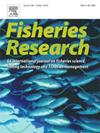从耳石生物年代学分析本格拉北部沙丁鱼崩溃后的躯体生长和种群恢复失败
IF 2.2
2区 农林科学
Q2 FISHERIES
引用次数: 0
摘要
在纳米比亚的本格拉北部,沙丁鱼(沙丁鱼sagax)的数量在20世纪50年代到60年代支持了高捕鱼量,但在60年代末就崩溃了。尽管自2018年以来暂停捕捞,但到2023年,其数量仍未显示出恢复的迹象。在这项研究中,利用存档的沙丁鱼耳石建立了48年(1974-2021)的生物年代学。耳石增量宽度作为鱼类年生长的代表,使用线性混合效应模型进行分析,以探索导致鱼类年生长变化的内在(个体内)和外在(沙丁鱼生物量、海面温度和上升流)因素。由于缺乏20世纪60年代末种群崩溃之前的耳石数据,这意味着对崩溃后预测的沙丁鱼耳石年增长率的分析显示出短期波动,但没有显著的长期增长率变化。在南部春季,沙丁鱼年生长量与海温呈显著负相关,在17-20ºS(纳米比亚北部)区域与夏季上升流呈显著正相关。结果表明,环境条件对沙丁鱼的生长起主导作用,而极低的沙丁鱼生物量则加剧了环境条件对沙丁鱼生长的依赖。该研究为沙丁鱼生物量缺乏恢复背后的原因提供了见解。因此,耳石生物年代学为小型远洋鱼类如何应对环境变化提供了更广泛的理解。本文章由计算机程序翻译,如有差异,请以英文原文为准。
Post-collapse somatic growth and population recovery failure of sardine (Sardinops sagax) in the northern Benguela from otolith biochronologies
The sardine (Sardinops sagax) population in northern Benguela, Namibia, supported high catches in the 1950s-1960s and collapsed by the late 1960s. Despite a fishing moratorium since 2018, the population has shown no signs of recovery by 2023. In this study, a 48-year (1974–2021) biochronology was developed using archived sardine otoliths. Otolith increment widths, used as a proxy for annual fish growth, were analysed using linear mixed effects models to explore intrinsic (within individual) and extrinsic (sardine biomass, sea surface temperature and upwelling) factors contributing to annual variations in fish growth. The absence of otolith data from before the population collapse in the late 1960s meant that the analysis of predicted annual sardine otolith growth post-collapse showed short-term fluctuations but no significant long-term growth rate changes. Predicted annual sardine growth was significantly negatively linked with SST in Austral spring, and positively linked with upwelling in summer for the area 17–20 ºS (northern Namibia). The results suggest environmental conditions play a dominant role in driving sardine growth, exacerbated by the extremely low sardine biomass, which may be indicative of depensation. The study provides insight on the reasons behind the lack of recovery in sardine biomass. Therefore, otolith biochronologies provides a broader understanding of how small pelagic fish stocks respond to environmental changes.
求助全文
通过发布文献求助,成功后即可免费获取论文全文。
去求助
来源期刊

Fisheries Research
农林科学-渔业
CiteScore
4.50
自引率
16.70%
发文量
294
审稿时长
15 weeks
期刊介绍:
This journal provides an international forum for the publication of papers in the areas of fisheries science, fishing technology, fisheries management and relevant socio-economics. The scope covers fisheries in salt, brackish and freshwater systems, and all aspects of associated ecology, environmental aspects of fisheries, and economics. Both theoretical and practical papers are acceptable, including laboratory and field experimental studies relevant to fisheries. Papers on the conservation of exploitable living resources are welcome. Review and Viewpoint articles are also published. As the specified areas inevitably impinge on and interrelate with each other, the approach of the journal is multidisciplinary, and authors are encouraged to emphasise the relevance of their own work to that of other disciplines. The journal is intended for fisheries scientists, biological oceanographers, gear technologists, economists, managers, administrators, policy makers and legislators.
 求助内容:
求助内容: 应助结果提醒方式:
应助结果提醒方式:


